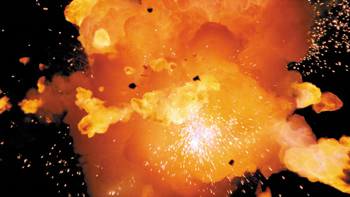Explosions
| The example forest fire shot also contained a large explosion in a clearing. There is not a huge fundamental difference between how you composite an explosion and how you composite fire, except that an explosion is far more likely to require a mixture of strategies. It is largely a question of what is exploding. All explosions are caused by rapidly expanding combustible gases; implosions are caused by rapid contraction. Just by looking at an explosion, viewers can gauge its size and get an idea of what blew up, however, so you need to design the right explosion for your situation, or your result will be too cheesy even for 1980s television sci-fi. How do you do it? Light and ChunkyEach explosion you will see is a little bit unique, but for the purposes of this discussion I'm going to organize all explosions into two basic categories. The easier one to deal with is the light explosion, one that is made up only of gas and heat. These behave just like fire; in fact, in the shot in Figure 14.21b the explosion is fire, a huge ball of it where something very combustible must have gone up very quickly. Some shots end up looking fake, however, because they use a light explosion when a more chunky explosion is called for. A chunky explosion is an explosion that also contains chunks of various types of debris. The need for debris to be included in the explosion is probably the primary reason that exploding miniatures are still used extensively these days or, when possible, full-scale explosions. The debris cues viewers to several important pieces of information about the shot. First of all, how big was the explosion? The slower moving and bigger the amount of debris, the bigger it probably was. For this reason, effects pyrotechnics tend to use miniatures shot with a high-speed camera. The resulting slow-motion effect makes the explosion seem much bigger than it was. If your shot calls for a chunky explosion and you don't have any chunks in your source, you need to add them somehow. Many 3D programs these days include effective dynamics simulations; if you go that route, be sure to generate a depth map as well because each chunk will only be revealed as it emerges from the fireball. There are lots of concerns associated with this that are beyond the scope of this discussion. The only effect that comes close to doing this for you in After Effects is Shatter, but it's hard to recommend this unless you're specifically breaking a pane of glass in your shot. Shatter isn't bad as a dynamics simulator, but its primary limitation is a huge one: It can use only flat polygons to model the chunks. A pane of glass is one of the few physical objects that would blow up into irregular but flat polygons, and Shatter contains built-in controls for specifying the size of the shards in the point of impact. Shatter was also developed prior to the introduction of 3D in After Effects; you can place your imaginary window in perspective space, but not using a camera or 3D controls. A wide selection of pyrotechnic explosions is also available as stock footage from such companies as Artbeats. In many cases, there is no substitute for footage of a real, physical object being blown to bits (Figure 14.23). Figure 14.23. Pyrotechnics footage is just the thing when you need a big explosion, filled with debris. (Images courtesy of Artbeats.)
|
EAN: 2147483647
Pages: 156

